The brain is an important organ that is responsible for controlling the functioning of the body. Every single activity our body does, be it active or passive, conscious or unconscious, is controlled and regulated by the brain. The brain is made up of many different parts and areas, each having very specific functions. The ventral tegmentum is one of these areas.
The ventral tegmentum is composed of a number of neurons that are located in the midbrain. They are found on the floor of the brain close to the midline brain. The ventral tegmentum plays a significant role in a number of functions, including those associated with reward.
With the ventral tegmentum being involved in a large number of functions and therefore being of significant importance, this may seem rather intimidating. There is no need to be, and we will provide you with all you need to know about the ventral tegmentum, from where it is located, to what it does, as well as what will happen should this area become damaged or diseased.
.
What Is The Ventral Tegmentum?
The ventral tegmentum is also known as the ventral tegmental area or the TVA. And may also be referred to as the ventral tegmental area of Tsai. Like many parts of the brain, the ventral tegmentum is made up of neurons. It is basically consists 3 types of neurons

The neurons of the ventral tegmentum help to form one of the two main dopaminergic centers in the brain, the other being Substantia Nigra. It is a tiny area of neurons that has many neural branches or axons that project out into the entire brain. These fibrous branches help to transmit various messages throughout the brain that help with both emotional and cognitive functioning.
Where is the Ventral Tegmentum Found?
The ventral tegmentum is found at the base of the brain, just above the brain stem. It neighbors the substantia nigra, which is the other major dopaminergic center of the brain laterally. There can often be very little physical difference between the ventral tegmentum and the substantia nigra, with both areas being very anatomically similar.
There are, however, differences in the neural pathways that lead off from both centers. There are many nerve pathways or efferent nerves that project from the ventral tegmentum, but the two main ones are the mesolimbic and the mesocortical pathways.
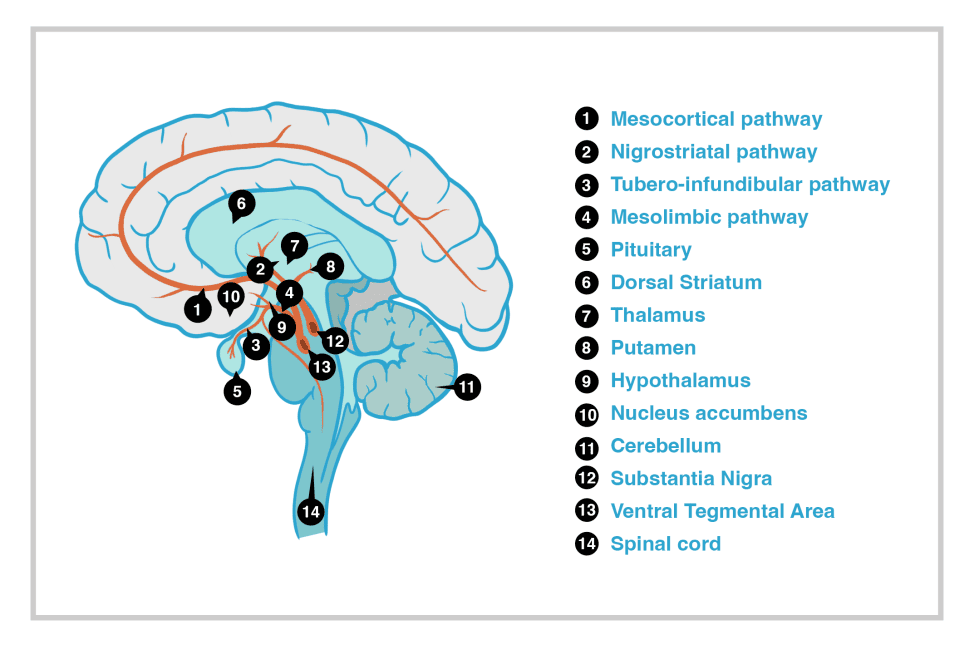
The ventral tegmentum is additionally found closer to the base of the brain, positioned almost centrally over the hippocampus region
Parts of Ventral Tegmentum
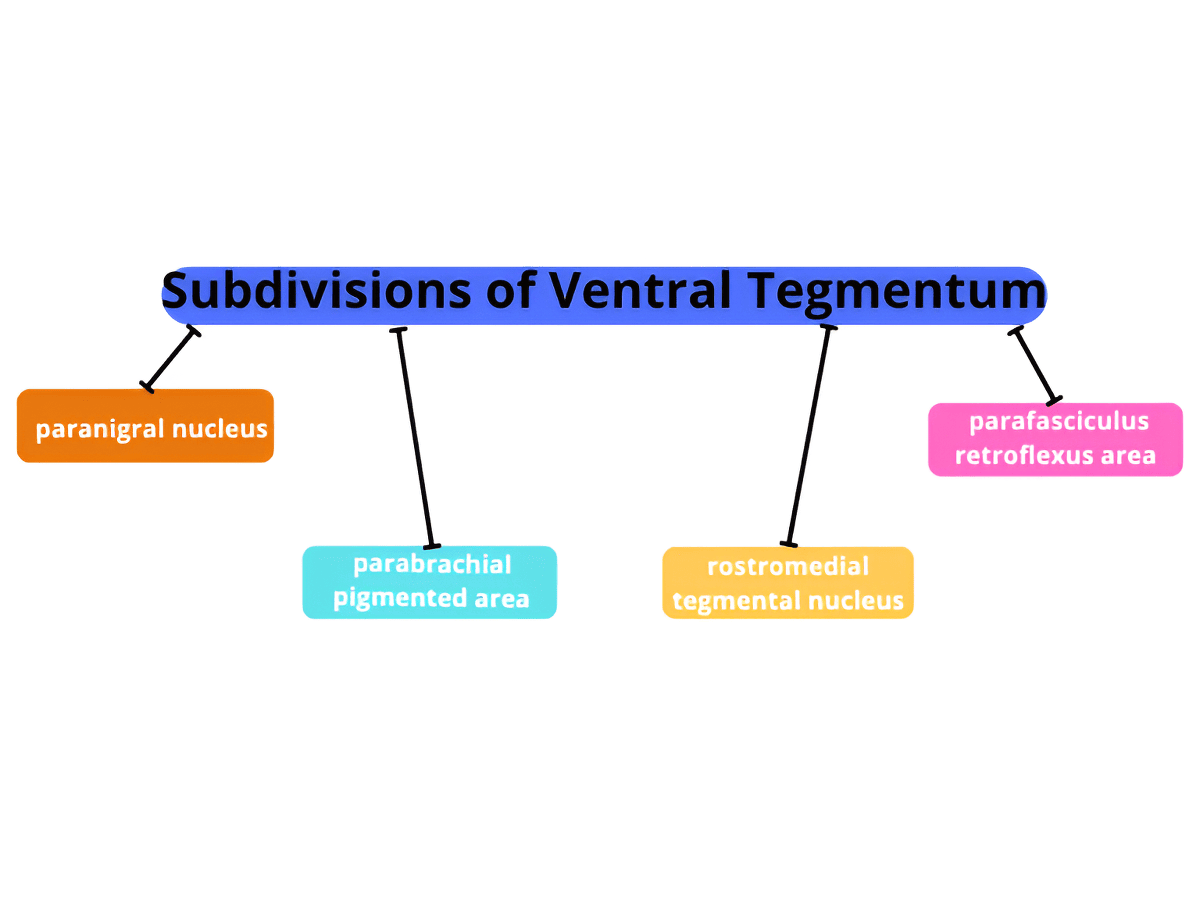
Of these four areas, the first two mentioned are largely dopaminergic neurons, while the last mentioned is mainly GABAergic cells.
To orient ourselves with different parts lets look at a beautiful diagram
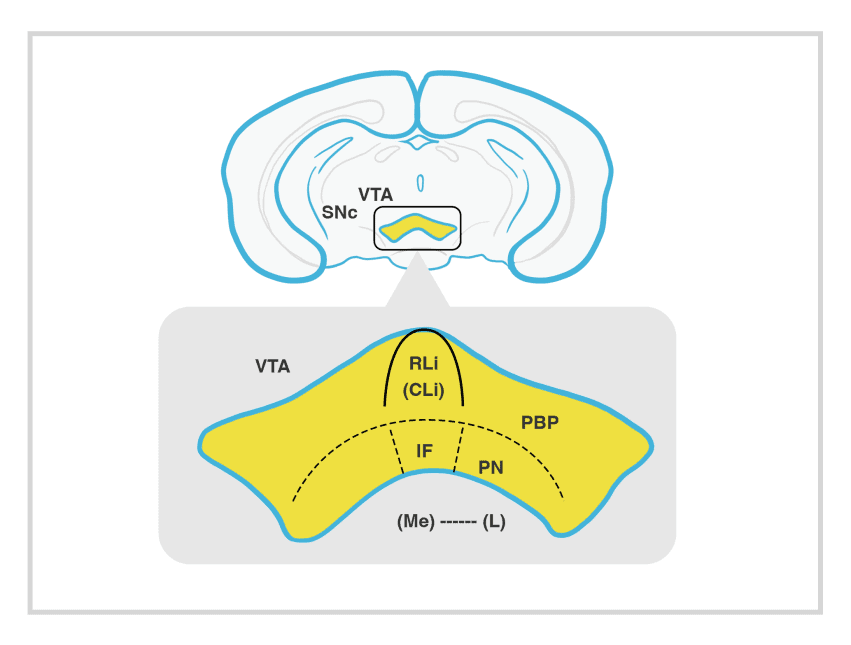
VTA= Ventral Tegmental Area, SNc= Substantia Nigra, PBP=Parabranchial Pigmented area, PN=Paranigral Nucleus, IF=Interfascial Nucleus or Para Fasiculus Reteroflux area , RLi= Roster Linear Nucleus or Rostro Medial Tegmental Nucleus
The projecting axons of the ventral tegmentum form the mesocorticolimbic projection, which is an important part of the limbic system.
What Hormone Does The Ventral Tegmentum Produce?
As noted above, the ventral tegmentum is one of the two main dopaminergic areas of the brain. It produces dopamine. We have a look at what dopamine is and what it does, as it is key to understanding the functions of the ventral tegmentum.
What Is Dopamine And What Is Its Function
Dopamine is a type of neurotransmitter molecule that functions as a neurotransmitter. Dopamine has long been considered the ‘happy hormone’ due to its association with pleasure and habit formation. As mentioned, the cell bodies of the group of neurons that make up the ventral tegmentum are one of the areas that produce dopamine.
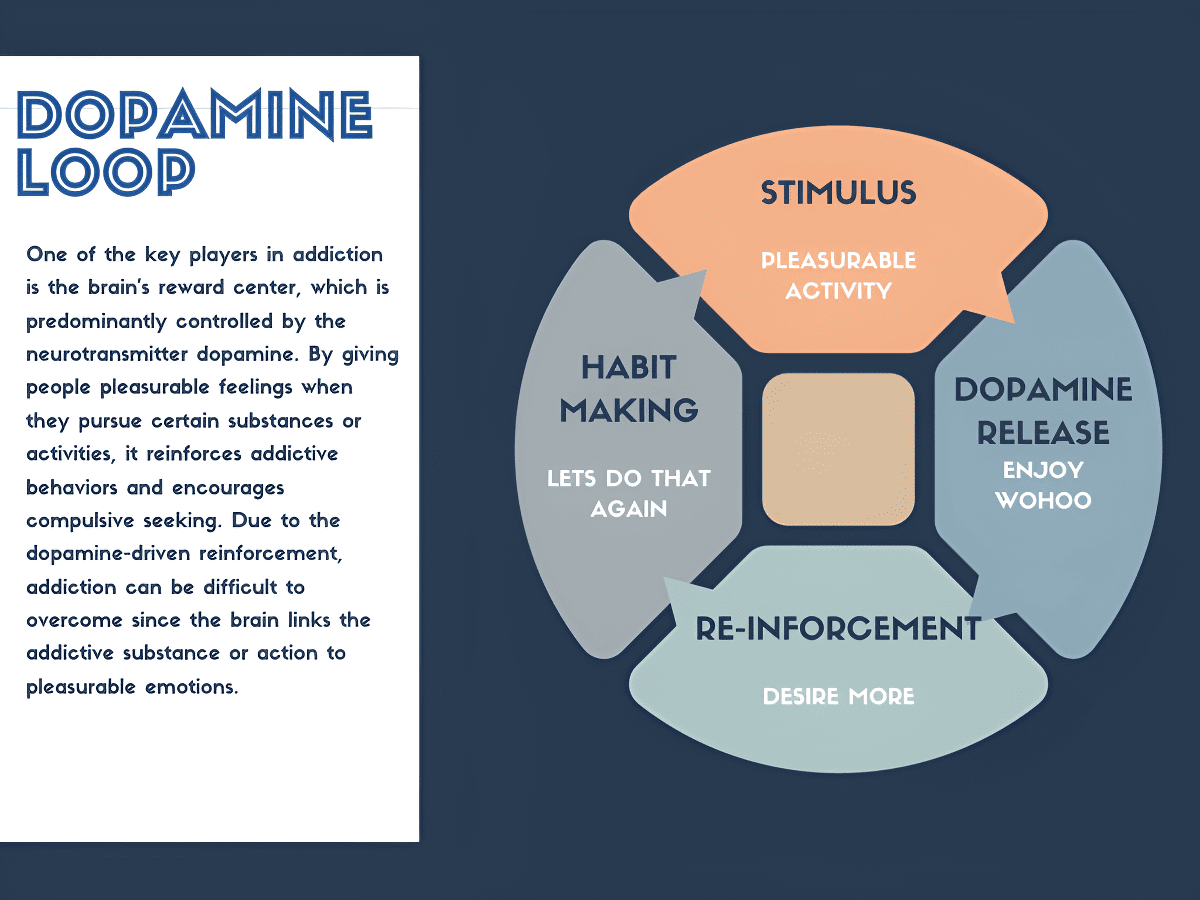
What Is The Function Of The Ventral Tegmentum?
The ventral tegmentum has a great many functions but is most well-known for the several roles it performs in the cognitive and emotional functioning of the human brain.
When dopamine is released, it travels via two pathways as far Ventral Tegmentum is concerned ; the mesocortical pathway and the mesolimbic pathway. The two pathways are also known as the mesocorticolimbic projection when referred to together.
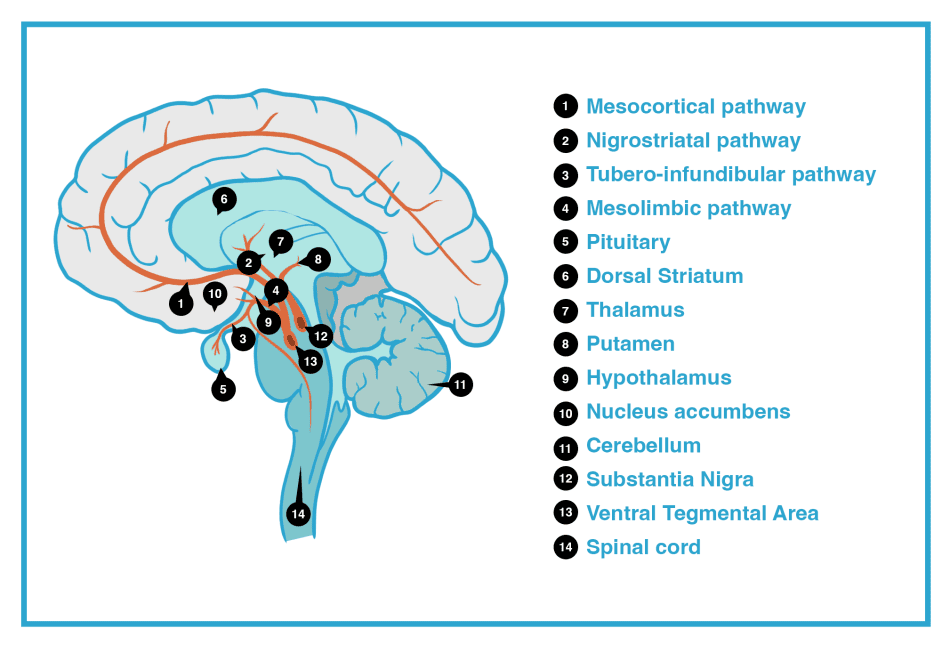
The mesocortical pathway leads to the prefrontal cortex, while the mesolimbic pathway leads to the nucleus accumbens.
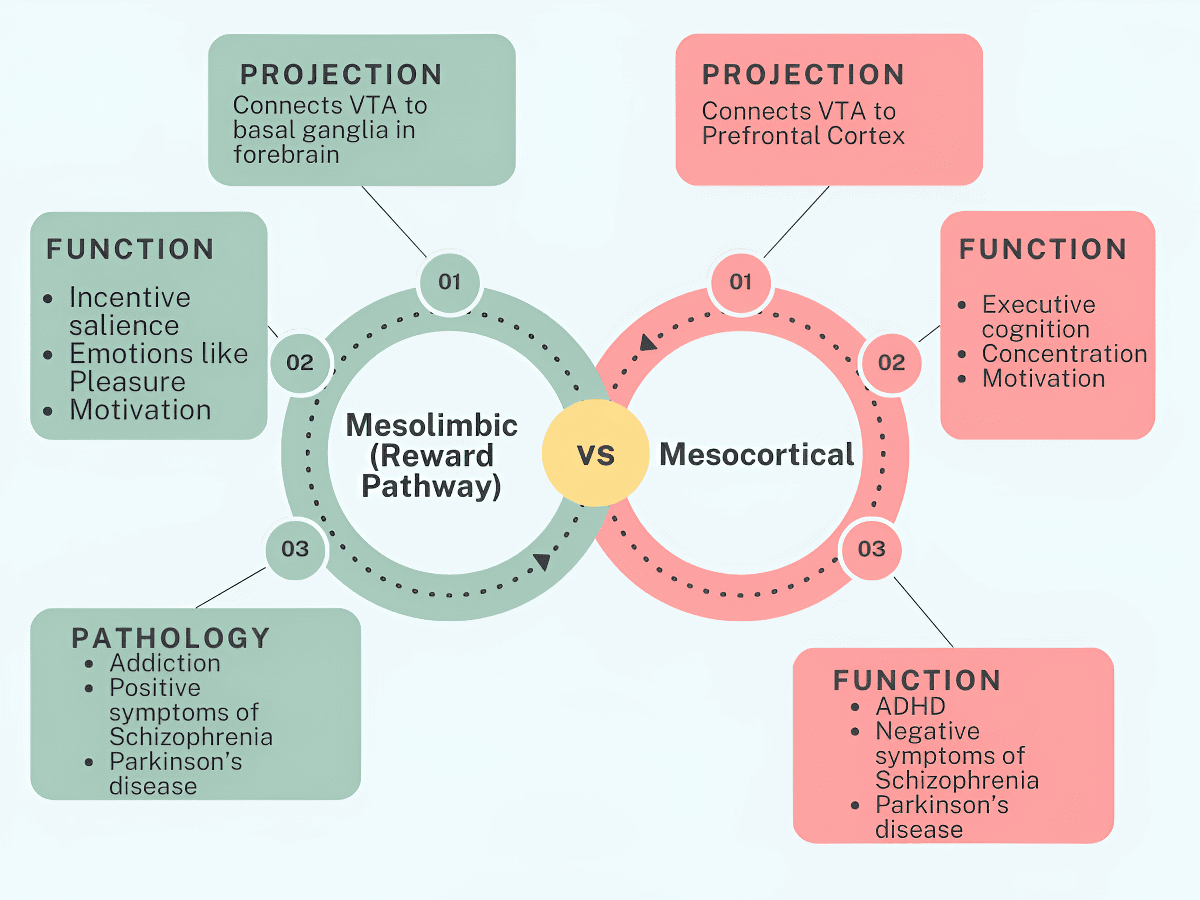
These pathways provide both input and output capability, and messages can be sent to the ventral tegmentum via these axons as well as to other parts of the brain from the ventral tegmentum.
The Most Well-known Function Of The Ventral Tegmentum
The most well-known function of the ventral tegmentum is the production and release of dopamine which has a critical role in functions such as:
- Reward
- Motivation
- Addiction
- Cognitive function
These functions are all interrelated. The ventral tegmentum plays an integral part in how the reward center of the brain works.
When the body receives a reward-related stimulus, the ventral tegmentum releases dopamine which is sent via the nerves that project from the ventral tegmentum area. The dopamine will then travel along this mesolimbic pathway to the area in the forebrain, otherwise known as the nucleus accumbens.
In the nucleus accumbens, the dopamine message will help us to consider the rewards of the stimuli and as well as motivate us to achieve them. The ventral tegmentum is therefore responsible for the incentive salience we experience.
This happy, blissful feeling we experience then motivates us to want more of the stimulus that caused it.
This is why the ventral tegmentum can also be an integral factor in addiction. Drugs can overstimulate the production of dopamine, creating a craving for the stimulus that is never satisfied. This results in addictive behavior in the pursuit of the 'happy' or 'high' that is experienced under the influence of the drugs.
Through its dopamine production, the ventral tegmentum is also involved in reward cognition which is necessary for species survival. The brain is able to determine the importance of something that is a good stimulus, and the dopamine release motivates the brain to want more of it.
Exercise, food, gifts, sex, praise, and admiration all serve as rewarding stimuli, and because of the good feeling we get from doing them, we are motivated to keep doing them. Thus resulting in better health, energy and ultimately survival.
Areas Linked To The Ventral Tegmentum Via Projections
Other than the prefrontal cortex and the nucleus accumbens, there are other areas of the brain that receive dopamine as a neurotransmitter via neural projections. These areas are:
- Amygdala
- Entorhinal cortex
- Olfactory bulb
- Cingulate gyrus
- Hippocampus
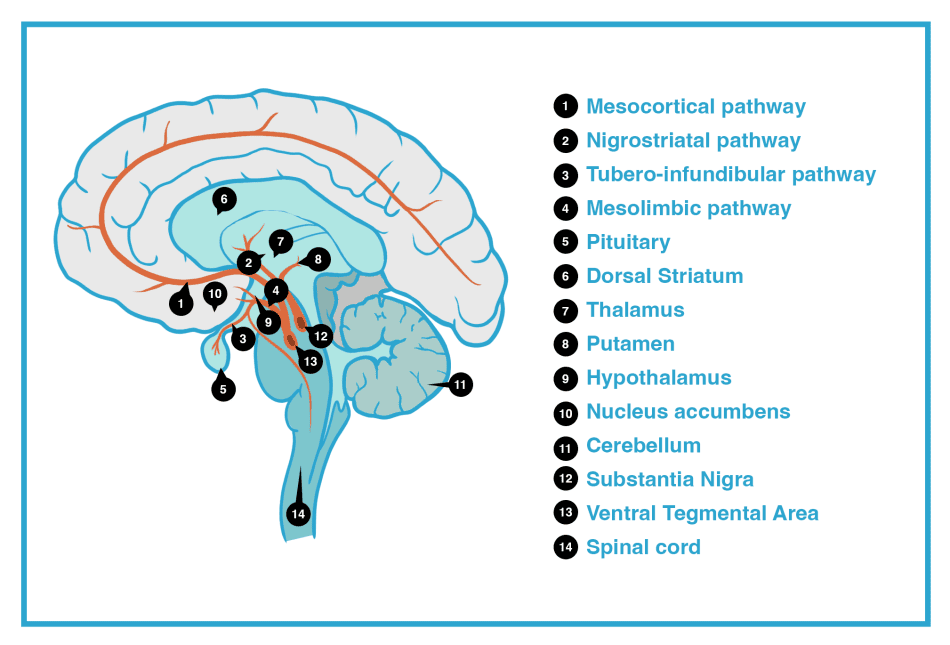
The widespread link of the ventral tegmentum to numerous parts of the brain helps explain how important it is in terms of properly functioning.
The amygdala is responsible for memory and decision-making and will also play a role in reward and emotional responses. The entorhinal cortex is also linked to memory. The olfactory bulb is linked to the sense of smell and can have a bearing on the cognitive interpretation of smell.
The cingulate gyrus has a bearing on motivation through behavior. The Hippocampus is associated with memory.
The majority of these brain areas form part of the limbic loop or limbic system, and many have crucial roles in the development, formation and retention of memory. This commonality helps us to understand an injury or disease to the ventral tegmentum can impact numerous areas of the brain.
Disorders And Disease Of The Ventral Tegmentum
As the ventral tegmentum is a critical component of both the mesolimbic and the mesocortical pathways, any disruption to these pathways can result in several disorders and diseases.
Disorders Associated With The Ventral Tegmentum
There are a few disorders that are associated with a damaged ventral tegmentum.
- Schizophrenia
- Attention Deficit Hyperactivity Disorder (ADHD)
Schizophrenia
Schizophrenia is a mental disorder that exhibits the inability to think, feel, or behave in a connected manner. People who suffer from schizophrenia cannot perceive reality coherently and will often create illusions and fantasies that will seem real to them while they withdraw from real-world interactions.
Schizophrenia has a lot to do with how the midbrain functions. Damage or developmental problems in the midbrain are often linked to schizophrenic diagnosis. The ventral tegmentum is a significant part of the midbrain, albeit small in size. Its pivotal role as a dopaminergic center means that any damage to the area can have a severe impact on schizophrenics as well as be possible evidence of the disorder.
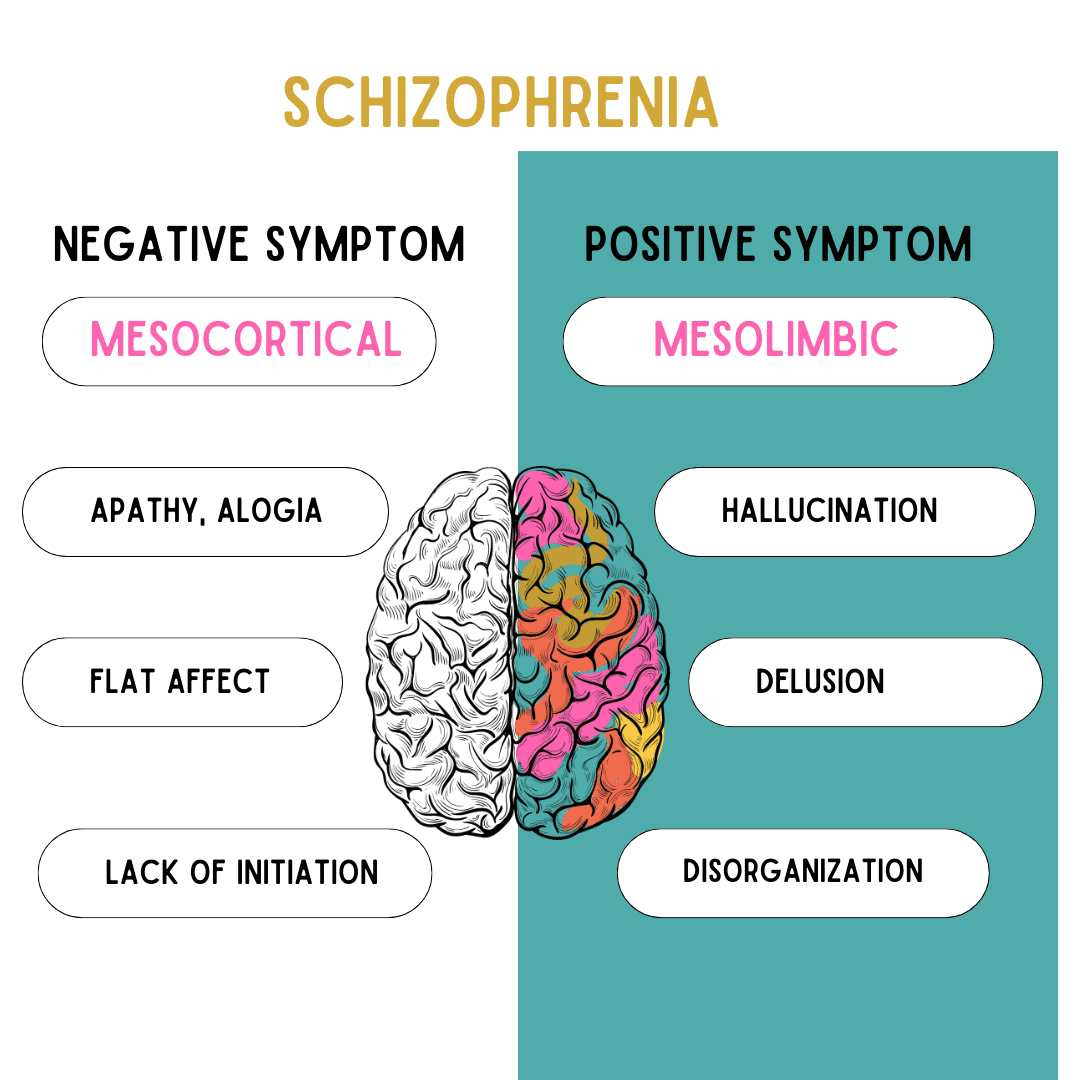
Schizophrenics have difficulty with memory and will additionally lack motivation. This memory loss can result in problems with decision-making – all of which are linked to the neurotransmitter dopamine.
Attention Deficit Hyperactivity Disorder
This disorder is a neurodevelopmental disorder that is known as Attention Deficit Hyperactivity Disorder (ADHD). ADHD is more generally diagnosed in children but can also remain into adulthood. This disorder is displayed as behaviors like hyperactivity, difficulty concentrating on a single task for longer periods, general inattention, as well as impulsiveness.
ADHD has links to a number of areas of the brain. As more research is done, we learn more about the disorder and which areas of the brain may impact its manifestation and development. It should be noted that there are generally several factors involved in the behavioral traits of ADHD.
The location of the ventral tegmentum at the base of the brain above the brain stem is thought to have a part to play in the onset of ADHD when there are developmental delays. The limbic link to several memory centers as well as the production of the hormone that governs pleasure response and incentive salience.
However, suppose there is delayed development in this area. In that case, the limbic system may not be able to function as well as stunts the ability of other areas that are responsible for memory, cognition or decision-making to misfire.
Disease Associated With The Ventral Tegmentum
The most common disease associated with damage or a breakdown of the functioning of the ventral tegmentum is Parkinson’s disease.
Parkinson's is a condition in which brain areas become increasingly damaged over time. It is most common in the elderly, starting from about 60 years old but can develop as early as 50. Parkinson’s results in an inability to control one’s movements with early symptoms, including uncontrolled tremors of the limbs.
The disease will also cause a loss of balance, the inability to properly move one's limbs and even the nerves of the face will be affected, along with a loss of smell. Parkinson's is mainly caused by low dopamine levels, which explains why the ventral tegmentum and its condition play a role in the disease.
Ongoing and progressive damage of the ventral tegmentum and other areas of the midbrain, like the substantia nigra will result in reduced dopamine production. Damage will occur in the limbic pathways, meaning that whatever dopamine is produced will have difficulty getting to where it needs to be to assist in proper bodily functions.
Conclusion
The ventral tegmentum, although significantly smaller than many areas of the brain, plays an integral role in brain functions. It plays a pivotal part in the limbic system, with its neural axons forming mesocorticolimbic projections that are the pathways for dopamine, amongst other hormones. This area is essential in how the brain translates reward stimuli, motivation, and pleasure.
The ventral tegmentum’s close association with several crucial brain areas through the limbic pathway system makes its damage or disease a serious complication that can result in numerous disorders and diseases such as schizophrenia, ADHD, as well as Parkinson's disease.
